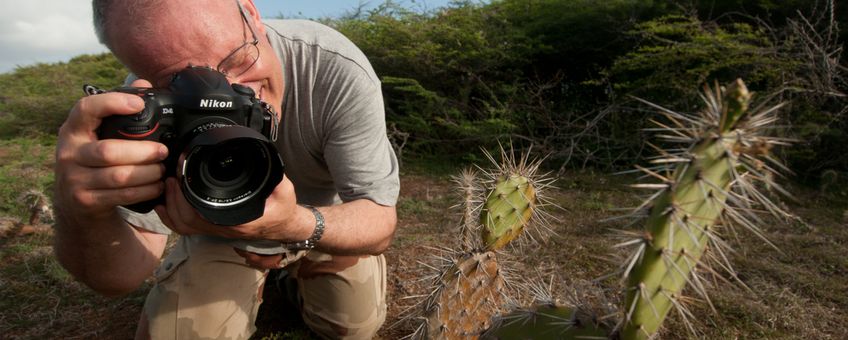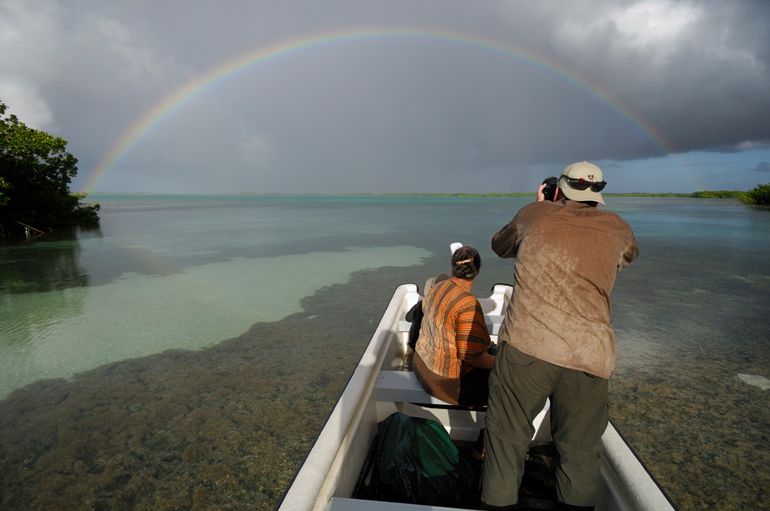
Using digital footprints to manage conservation efforts
Dutch Caribbean Nature Alliance (DCNA), Wageningen Environmental Research, Wageningen Marine ResearchThanks to modern technology, every time we upload a photo, a small amount of data is included with the image. With the popularity of social media, we now leave a trail of digital footprints where ever we go. Researchers can now compile thousands of photos and, with the use of computer algorithms, complete a detailed analysis which provides insight to policy makers, tourist organisations and park managers. Understanding how many people visit and use a location can help implementing crowd control measures, estimate tourist behavior and give possible insights into the impact this may have on the environment.

Within the context of the WUR Knowledge Basis project ‘Nature inclusive planning on small tropical islands’, researchers from Wageningen Research studied photos from Bonaire taken and uploaded onto the photo application Flickr between November 2002 and October 2019. In the end, 13,026 photos from 421 photographers contributed to this research. Using geo-tagged photos, these researchers were able to map tourist densities, recreation routes, places visited and how long individuals stayed on the island. Photos were analyzed and categorized as coastal, seascape (i.e. sunsets, watersports), terrestrial, underwater, wildlife or other (i.e. cultural, historical, people).
In addition, information concerning the photographer’s origin and type (cruise boat, stay over tourist or local) were collected. The objective was to link the type of tourist with their various interests to potentially offer marketing suggestions for the future. Using public data available on each photographer, they were identified as being local (only Bonaire), Latin American (including other Caribbean islands), North American, European or other (which also included individuals who could not be identified). Next, based on the length of time between their first and last photos, they were categorized as cruise boat tourists (less than a day), stay over tourists (less than a month) or locals (a month or more).

Overall, the distribution of photos taken around the island were seen to match expectations, with the higher densities being located along the west coast and near other tourist areas such as Sorobon, Goto Meer, slave huts and Slagbaai National Park. Underwater pictures had the highest numbers around popular dive sites, such as the Hilma Hooker ship wreck, Salt Pier, Buddy Dive, Karapata and Andres I/II.
Interestingly, stay over tourists account for 50 percent of the data analyzed with cruise tourists making up 40 percent. In addition, stay-over tourists were more likely to visit hard to reach locations (such as Slagbaai National Park or Klein Bonaire) whereas cruise boat tourists were more densely packed around Kralendijk. This makes sense as cruise boat tourists are often only given a short amount of time on the island, so most choose to stay near the boat.
This data also showed that most of the photographers originated from North America (39 percent), followed by other (mostly unknown) (28 percent) and Europe (26 percent). Additionally, this information could be further broken down to highlight the points of interest by demographic, showing that Latin Americans seem to take more coastal photographs, and Europeans and North Americans taking more underwater and wildlife photographs. Researchers suggested this could be due to the fact that the local wildlife on Bonaire may be more familiar to people from Latin America so they are less likely to take photographs.
Furthermore, stay-over tourists were much more likely to take underwater and wildlife photos when compared to cruise boat tourists. This is likely due to cruise boat tourists not having enough time to plan a dive or venture far away from Kralendijk. In turn, cruise boat tourists were much more likely to take photos of cultural points of interest, buildings and people.
Impacts
Studying spatial patterns and distributions of tourists can help highlighting vulnerable habitats which may be overrun by tourists. Given more extensive research, these patterns can be used to design marketing and educational information to target each photographer type to maximize conservation efforts.
Report your sightings
In addition to uploading your beautiful photographs to social media, you can also report any sightings or photos of any wildlife species on Dutchcaribbean.observation.org. This is a free website and app (iPhone (iObs) & Android (ObsMapp)) which allows local citizens to report sightings of important plants and animals. These tools are available in over 40 languages and can be used by biologists, citizens and tourists alike. Species reports by local communities are invaluable for nature conservation efforts to help to increase public awareness and overall species protection. Besides, Observation.org is working together with Naturalis Biodiversity Center on automated species identification software. Your uploaded photos are of great value to make this possible. For questions, please contact research@DCNAnature.org.
More information
- Read the full report: Tracking digital footprints in Bonaire’s landscapes (pdf: 4,3 MB) written by D. Slijkerman, J.T. van der Wal, P. de Vries and P. Verweij.
- Nature inclusive planning, a vision for Small Island Development States.
Text: Dutch Caribbean Nature Alliance, Wageningen Marine Research & Wageningen Environmental Research
Photo's: Henkjan Kievit & Christian König, DCNA/Shape
